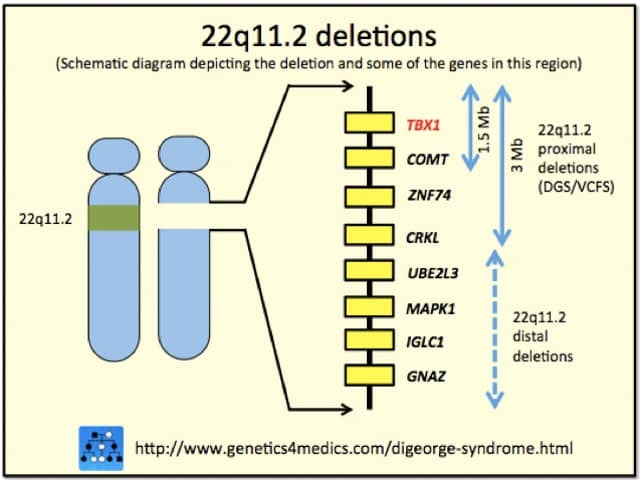Main menu
Common skin conditions

NEWS
Join DermNet PRO
Read more
Quick links
DiGeorge syndrome — extra information
DiGeorge syndrome
Author: Brian Wu PhD. MD Candidate, Keck School of Medicine, Los Angeles, USA; Chief Editor: Dr Amanda Oakley, Dermatologist, Hamilton, New Zealand, October 2015.
Introduction Causes Signs and symptoms Complications Diagnosis Treatment
What is DiGeorge syndrome?
DiGeorge syndrome is a rare primary immunodeficiency disorder with a wide range of presenting signs and symptoms. It is due to chromosomal defects that arise early in gestation.
DiGeorge syndrome is also called velocardiofacial syndrome, shprintzer syndrome, CATCH22 and 22q11.2 deletion syndrome.
What causes DiGeorge syndrome?
DiGeorge syndrome is caused by dysfunctional development of certain cells and tissues in utero. Approximately 90% of the patients with DiGeorge syndrome have a deletion of a segment of 30–40 genes on chromosome 22. Generally, this is considered to be the consequence of a random event in either the egg or the sperm, but more rarely it can be passed on from parent to child.

DiGeorge syndrome
*Image courtesy Genetics 4 Medics
What are the signs and symptoms of DiGeorge syndrome?
Because there is great phenotypic variability associated with this syndrome, one patient may present with vastly different symptoms from another. Possible symptoms include:
- Respiratory: difficult breathing, cyanosis
- Musculoskeletal: twitching/spasms of the periorbital muscles and muscles in the limbs, muscle weakness and poor tone
- Immunological: frequent infections
- Neurological/behavioural: delayed development, learning disabilities or behavioural problems
DiGeorge syndrome patients also generally present with distinctive facial characteristics, including:
- An under-developed chin
- Low-set ears
- Wide-set eyes
- A deep groove in the upper lip
- Cleft palate or other palate abnormalities
What complications can arise from DiGeorge syndrome?
Possible complications arising from DiGeorge syndrome are varied and may include:
- Cardiac conditions, including heart defects such as ventricular septal defect, truncus arteriosus or tetralogy of Fallot.
- Endocrinological issues including hypoparathyroidism or thymus gland dysfunction
- Psychiatric/neurological issues such as attention deficit hyperactivity disorder, autism spectrum disorder, depression, anxiety and schizophrenia
- Sensory disorders such as auditory and/or visual impairment
- Immunological: increased susceptibility to bacterial, viral and fungal infections and an increased risk for autoimmune disorders, most commonly idiopathic thrombocytopenic purpura, autoimmune haemolytic anaemia, autoimmune arthritis and autoimmune thyroid dysfunction.
How is DiGeorge syndrome diagnosed?
DiGeorge syndrome is diagnosed based on patient signs and symptoms, the presence of a heart defect (though this by itself is not diagnostic), and genetic testing, fluorescence in situ hybridisation (FISH), is used to determine deletion in chromosome 22.
How is DiGeorge syndrome treated?
There is no cure for DiGeorge syndrome. Treatment is based on correcting or managing secondary problems wherever possible. This can include:
- Surgical correction of a cleft palate or cardiovascular defects
- Transplantation of thymus tissue for a severe dysfunction of the thymus gland
- Calcium and vitamin D supplements for hypoparathyroidism
- Speech, physical or occupational therapy to counteract developmental delays/deficits
- Anti-depressants, anti-anxiety agents or other psychotropic drugs and therapy to treat psychiatric disorders
References
- DiGeorge syndrome — The Mayo Clinic 2014.
- DiGeorge syndrome — Immune Deficiency Foundation 2014.
On DermNet
Other websites
- DiGeorge Syndrome — Medscape
- DiGeorge syndrome — NHS choices
- DiGeorge syndrome — OMIM #188400
- 22q11.2 deletion syndrome — Genetics Home Reference
